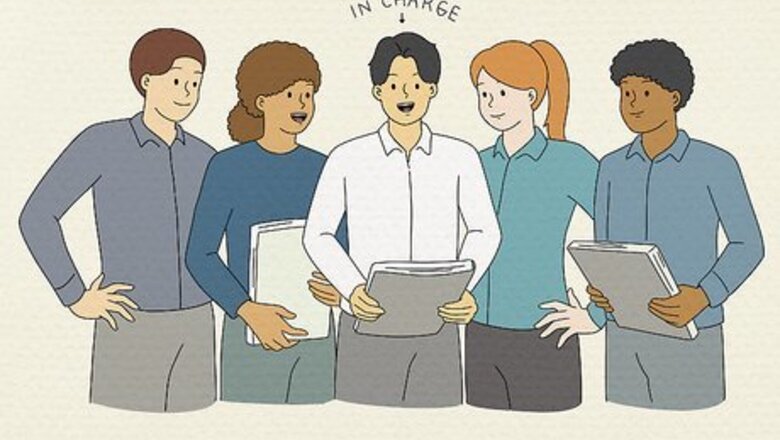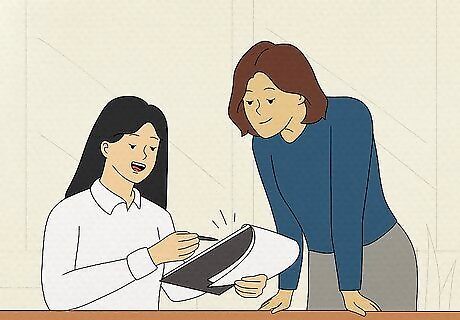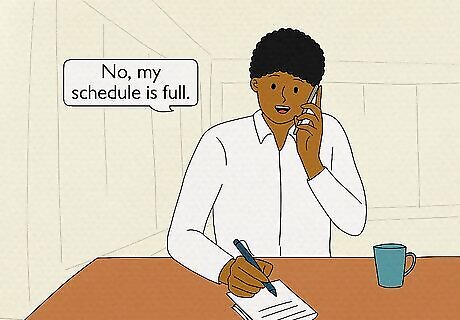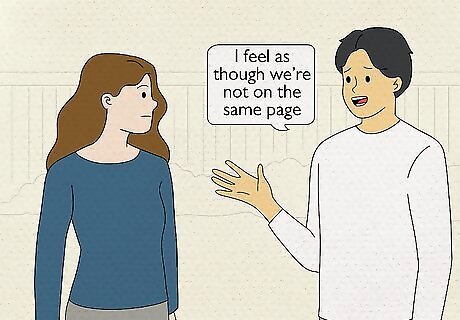
views
- A power dynamic is a social system that develops between 2 or more people to determine who’s in charge.
- A power dynamic can be healthy or unhealthy. Power that isn’t distributed evenly can quickly turn toxic.
- To build a healthy dynamic in relationships, work on setting boundaries, being honest, and addressing conflicts right away.
What are power dynamics?

Power dynamics are the balance or imbalance of a relationship. Think about it: when 2 or more people are together, a power or social construct is in place (whether conscious or unconscious). One person usually takes charge, while the other sits back. This is an example of a power dynamic. Power dynamics can be healthy or unhealthy within relationships, friendships, and businesses. Power dynamics can refer to the formal authority distributed within a group of people or relationship, or it can show informal ways power is shown within an organization. Imagine power dynamics like a scale. Healthy power dynamics balance each other out, providing equal power and support, while unhealthy power dynamics lean more to 1 side than the other.
How do power dynamics affect relationships?

In relationships, power dynamics reflect how couples interact. Power dynamics play an important part in romantic relationships, influencing how a couple resolves conflict and interacts with each other. In relationship psychology, there are 3 common dynamics: demand/withdrawal, distancer/pursuer, and fear/shame. More often than not, these dynamics are imbalanced, and balancing them can help cultivate a healthy and lasting relationship. Demand/Withdrawal: When 1 person feels their needs aren’t being met. The “demander” may always be asking for something (attention, intimacy, emotional support), while the “withdrawer” responds by avoiding their partner. Change this dynamic with respectful communication. Sit down with your partner and express your relationship wants and needs equally. Distancer/Pursuer: When 1 person is more invested in the relationship than the other. The “distancer” puts emotional and/or physical space between themselves and their partner, while the “pursuer” actively seeks to bring themselves closer to them. Balance this dynamic by stepping out of your comfort zone, planning weekly dates, and/or discussing what you both want from the relationship. Fear/Shame: When 1 or both partners are avoidant because their scared or ashamed of intimacy. This often leads to withdrawal and/or aggressive behaviors toward one another and results from unresolved trauma. Change this dynamic by seeing a therapist to find peace with your past. Work on building trust with yourself and your partner to strengthen intimacy.
Examples of Power Dynamics

Formal authority power Formal authority power stems from a person’s position. When someone has this power dynamic, they’re able to tell people what to do and/or make decisions because they have the authorization to do so. In the workplace, this dynamic is normal and can look like your boss asking you to complete a specific task even if you don’t want to do it. In relationships, this power dynamic can be toxic and involves 1 partner having control over the other. In friendships, formal dynamics can be unhealthy and may involve 1 friend bossing other friends around.

Charismatic power A charismatic dynamic comes from someone’s charm and appeal. Those with this power can naturally get people to do their will. They don’t necessarily mean to use their power—people love them so much that it just happens! In the workplace, this dynamic may pop up when an extremely friendly or good-looking coworker asks you for a favor, and you find yourself saying “yes” without batting an eye. In relationships, this power may occur if 1 partner is an exceptionally good talker or attractive. In friendships, this dynamic can happen if your friend group has 1 friend you all fawn over.

Expert power Expert power dynamics occur when someone is extremely knowledgeable or skilled. Also known as informational power, this dynamic is awarded when someone rightfully earns a position based on what they know or can do. In the workplace, this power dynamic can look like being put on a project because you have excelled on similar projects before. In relationships, this type of power can look like your partner advising you how to make dinner because they usually cook. In friendships, this dynamic may occur if you meet a friend at their home in a place you’ve never been before.

Coercive power Coercive power dynamics use threats and force to gain power over people. This power dynamic can be the most toxic, as it can hinder people from pursuing their dreams and passions. In the workplace, this power can look like a manager giving you a poor review. In relationships, this dynamic may occur if your partner stops you from calling a friend or relative. In friendships, this power dynamic could look like a friend threatening to tell your crush you like them.

Connection power Connection power dynamics allow people to connect over mutual goals or interests. This type of power is very healthy and can help people become closer. In the workplace, this dynamic can look like a recruiter connecting you to an employer and a job you’re qualified for. In relationships, this power may happen if you and your partner find a new date night activity you both enjoy. In friendships, this dynamic type can help you find friends in clubs, organizations, or everyday outings.

Gender power Gender power dynamics revolve around the societal notion that men are above women. Although every organization and relationship is different, there may be biases on who gets the most power depending on if someone’s male or female. To put it simply, gender power runs on stereotypes. In the workplace, this dynamic can look like a man getting hired over or paid more than a woman. In relationships, this power may occur if a male partner refuses to cook or clean because he’s a man. In friendship, this dynamic could look like a female friend being scared to be called “sensitive” in front of male friends.

Asymmetrical power Asymmetrical power dynamics aren’t distributed evenly but are always fluid and relative. This dynamic focuses on the idea that some people will always have more power than others—that’s just the way the world works! However, it’s how you use the power to your advantage that matters. In the workplace, this power can look like accepting that your boss makes the rules and you must follow them to get paid. In relationships, this dynamic can be toxic and might occur if you don’t feel like you’re on an equal playing field with your partner. In friendships, this power is understanding that the freshman of your school looks up to you as a senior, so you should set a good example.
How to Build Healthy Power Dynamics

Set boundaries. Making clear boundaries is a great and healthy way to establish power dynamics at work and in personal relationships. Clarify what you want and need in the given situation or partnership. This way, both parties can give and receive the perfect amount of power while maintaining a healthy relationship. Boundaries can look like saying “no” to extra work tasks when your schedule’s full, asking friends to stop calling after a specific time, or mentioning to your partner that you prefer hand-holding over hugs.

Be open and honest. One of the best ways to balance power dynamics is to express what you want and need within the relationship—it’s okay to discuss power dynamics! This is not only important with your partner, friend, or coworker, but it’s also important for yourself. Share what would benefit you in the relationship to shape the dynamic. Use “I” statements to explain what you want and need from the partnership. For instance, statements like, “I’d like a raise” and “I feel as though we’re not on the same page” radiate confidence. Not sure what you want? Try journaling to sort through and process your thoughts.

Get to know who you’re working with. Everyone is different, and everyone has different strengths. Some power dynamics can work better for others while others don’t, and that’s okay! Having a clear idea of who your partner is and what the relationship can become is a great starting point for creating healthy power dynamics. Work on getting to know your crush, friend, or coworker before diving into a relationship or project. Try asking them fun questions or inquiring about their favorite movies or hobbies.

Address issues with power dynamics. If you don’t feel heard within the relationship, speak up (if it’s safe to do so)! Addressing power dynamics at work or within a personal relationship can help clear your mind and the air. Discuss if you feel uncomfortable with how the power’s divided and what you want to change. For example, say your boyfriend refuses to do the dishes because he believes it’s a job for a woman. Let him know how this stereotype makes you feel by saying something like, “It hurts my feelings that you think I’m the only one who’s able to do household chores. I’d appreciate it if we could do them together.” As another example, pretend your boss threatens to fire you unrightfully. Talk to HR about the incident. In another instance, perhaps a friend starts bossing your friend group around while you’re working on a school project. Kindly ask the group what roles everyone would like to have, then evenly distribute them. This way, 1 friend can’t dictate everyone’s jobs—you all get a chance to choose.
Can you change power dynamics?

Power dynamics can change in certain situations. In some instances, changing or balancing a power dynamic is easier said than done. Power dynamics in the workplace, for instance, are usually fixed unless dramatic changes are made at a company or management level. On the other hand, romantic and friendship dynamics can be balanced if both parties are willing to make positive changes to better their relationship. Think of it this way: power isn’t fixed; it’s dynamic! Power can change quickly in a company or relationship because it’s fluid and dependable on who’s in charge.
Why is understanding power dynamics important?

Understanding power dynamics is essential to effective communication. Believe it or not, grasping the idea of power dynamics can help you be a better communicator. Knowing where you stand in society (whether that’s with your boss, partner, or friends) can give you a leg up when it comes to getting what you want and making connections. In the workplace, understanding where you stand within the company can help you better communicate your needs as an employer and negotiate potential raises. In relationships, knowing the type of power dynamic you have as a couple can help you learn what you need to work on to strengthen your relationship. In friendships, power dynamics help you understand where you stand with your peers so you know who to talk to about specific topics.
















Comments
0 comment